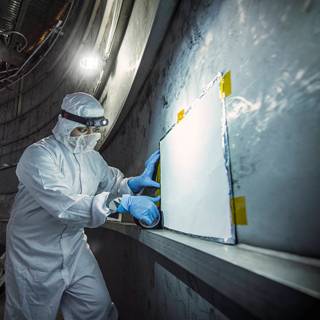Jun 29 2015
Engineers at NASA have developed a Molecular Adsorber Coating (MAC) that can help protect delicate instruments, satellites and the James Webb Space Telescope from contamination due to outgassing.
 Thermal Coatings Engineer Nithin Abraham places a MAC panel at the very bottom of the Chamber A where the Webb telescope will be tested. Credits: NASA/Chris Gunn
Thermal Coatings Engineer Nithin Abraham places a MAC panel at the very bottom of the Chamber A where the Webb telescope will be tested. Credits: NASA/Chris Gunn
Delicate instruments can be affected by contamination. "Outgassing" is a process that takes place when a substance emits a vapor or odor that causes contamination. This affects sensitive satellite instruments and the health of people too. A well known example of outgassing is the smell emitted by a new car.
"The Molecular Adsorber Coating (MAC) is a NASA Goddard coatings technology that was developed to adsorb or entrap outgassed molecular contaminants for spaceflight applications," said Nithin Abraham, Thermal Coatings Engineer at NASA's Goddard Space Flight Center in Greenbelt, Maryland. Abraham had recently placed MAC Panels in the giant testing chamber at NASA Johnson Space Center in Houston, Texas. The Webb telescope is to be tested in this chamber, with the panels acting as a contamination mitigation tool.
The MAC panels can capture outgassing emitted by the components, hardware and from within instrument cavities. They can also prevent outgassing from entering the chamber.
At the Space center, MAC is capturing the outgassed contaminants that are outside the test chamber, and preventing them from affecting the Webb components. MAC would only be capturing outgassed contaminants in the vacuum chamber space, and would not be capturing any outgassed contaminants from the Webb components.
"Although we cannot stop contaminants within the vacuum chamber from outgassing, we can try to capture them with MAC before it tries and reaches the expensive hardware, which are housed inside the test chamber," Abraham said.
In order for the Chamber A thermal-vacuum test facility to be suitable for the first Optical Ground Support Equipment (OGSE-1) of the James Webb Space Telescope, customized MAC-coated test panels were designed and fabricated in May 2015.
"The MAC panels were installed in very strategic locations within Chamber A to capture vacuum chamber contamination originating from persistent sources, such as silicone pump oil residue and hydrocarbons," Abraham said.
Certain silicone-based contaminants have the property of outgassing easily and spreading at ambient temperature conditions. These contaminants cannot be cleaned or removed easily. MAC panels could help reduce the risk of contamination and prevent outgassed components from being deposited on the optical hardware surfaces of the Webb telescope.
At NASA's Goddard Space Flight Center in Greenbelt, Maryland, a team created a sprayable paint that has the ability to adsorb gaseous molecules, and prevent them from attaching to instrument components. This patent-pending paint was made of zeolite and a colloidal silica binder that functioned as a glue that kept the coating together. Zeolite is a mineral that is used for a wide range of applications including water purification applications. The resultant paint is a molecular adsorber that has the desired properties to catch the outgassed contaminants. This adsorber is highly porous and permeable.
The Chamber A has been used for testing Apollo mission’s space capsules both with and without their crew. Presently, it is the world’s largest cryogenic-optical high-vacuum test chamber, measuring 16.8 m in diameter and 27.4 m in height. The 40 ton door is operated hydraulically.
NASA is leading the Webb project along with the Canadian Space Agency and the European Space Agency.
The James Webb Space Telescope will become the most powerful space telescope after its construction, and it is the successor to NASA's Hubble Space Telescope.